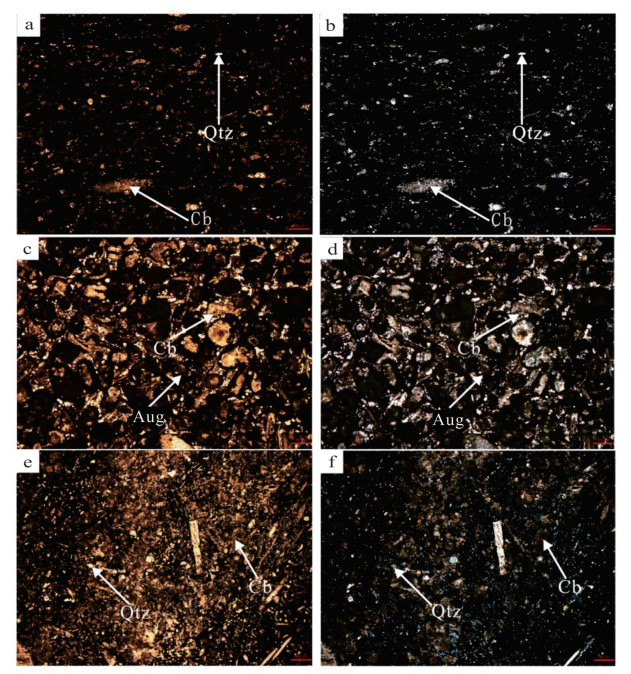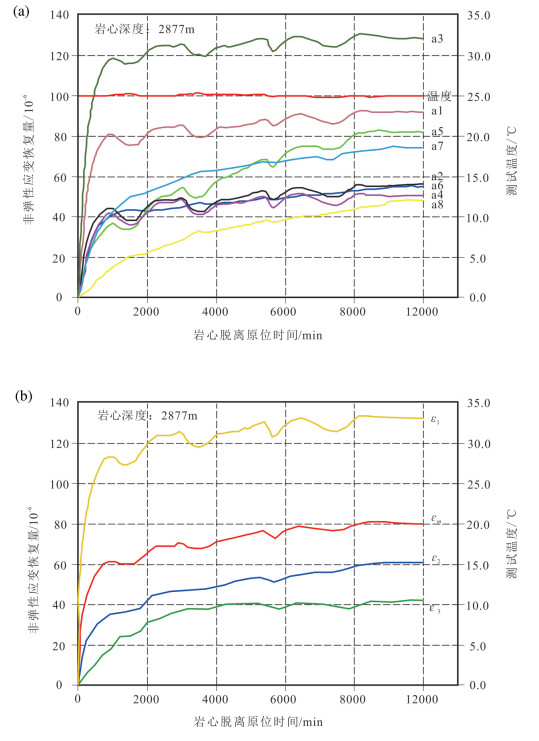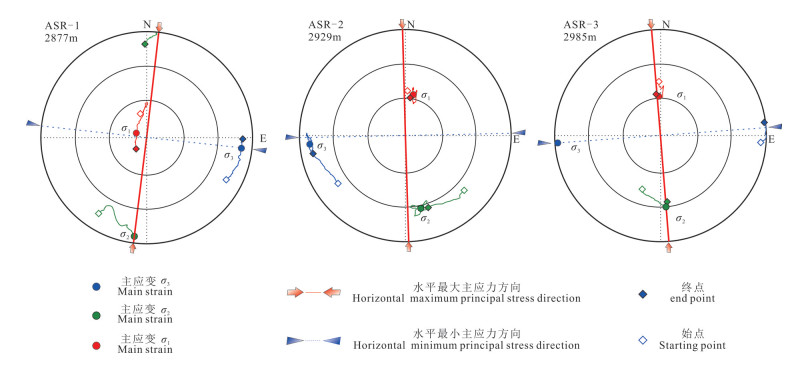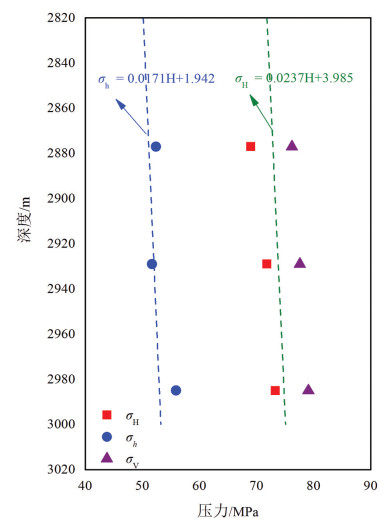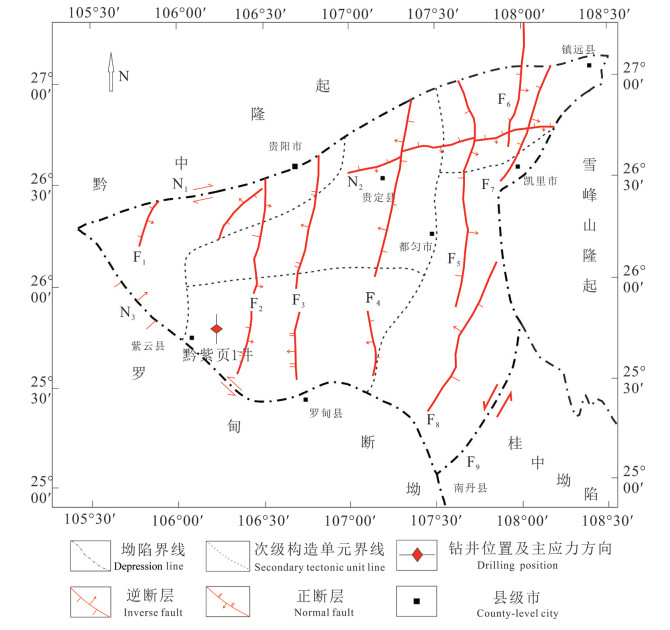In-situ stress determination of 3 km oil-gas deep hole and analysis of the tectonic stress field in the southern Guizhou
-
摘要:
地应力大小和方向信息是非常规油气勘探开发及区域构造应力场特征分析的重要基础数据。为了解黔南紫云地区的现今地应力状态,采用基于钻孔岩心的非弹性应变恢复(ASR)地应力测量方法,获取了紫云地区2877~2985 m石炭系打屋坝组地层的地应力信息,分析了区域构造应力场特征,探讨了油气保存条件。结果表明:(1)黔南紫云地区近3 km处石炭纪地层现今地应力状态表现为以垂向应力为主的应力环境,测点处最大水平主应力方向近SN向。(2)紫云地区近3 km处岩心实测最大水平主应力方向与燕山早期古构造应力场最大主应力方向大致相同,一定程度上反映了燕山末期—喜马拉雅运动对次生油气藏的改造程度较小,有利于黔南坳陷内部油气藏的保存。
Abstract:The magnitude and direction of stress are important basic data for unconventional oil and gas exploration and analysis of regional tectonic stress field. In order to find out the present stress state in southern Guizhou area, the authors applied the Anelastic Strain Recovery (ASR) method to obtain the in-situ stress state in Carboniferous Dawuba Formation of southern Guizhou Area (Qianziye-1 well) ranging from 2877 to 2985 m in depth. Based on the features of regional tectonic development in Qiannan depression, the authors investigated the characteristics of regional tectonic stress field and the preservation conditions of oil and gas. The results show that the Carboniferous Dawuba Formation in southern Guizhou area gas retaining the normal fault stress regime, the orientation of maximum horizontal principal stress at the measuring point was in nearly SN direction, which was the same as the maximum principal stress direction of the paleotectonic stress field in the Yanshanian period. The late tectonic movements occurred mainly along faults, which suggests a relatively minor damage to the secondary oil and gas pools during the last phase of YanshanHimalayan movement. It is conducive to the preservation of oil and gas reservoirs in Qiannan depression.
-

-
表 1 ASR法样品波速测试检验各向异性
Table 1. The rock sample velocity test and anisotropy of ASR method

表 2 ASR法地应力测量样品信息及古地磁定向结果
Table 2. The rock sample information and paleomagnetic directional results by ASR method

表 3 黔紫页一井ASR岩心原位测试应力结果
Table 3. Magnitude and azimuths of in-situ stress by ASR method at Qianziye-1 well

-
Chen Qunce, Feng Chengjun, Meng Wen, Qin Xianghui, An Qimei. 2012. Analysis of in situ stress measurements at the northeastern section of the Longmenshan fault zone after the 5.12 Wenchuan earthquake[J]. Chinese J. Geophys., 55(12):3923-3932 (in Chinese with English abstract). http://www.wanfangdata.com.cn/details/detail.do?_type=perio&id=dqwlxb201212005
Chen Xiaobin. 2009. The present horizontal deformation of China's land and its driving mechanism[J]. Science in China(Series D:Earth Sciences), 37(8):1056-1064(in Chinese).
Chen Xiaohong, Wei Kai, Zhang Baomin, Li Peijun, Li Hai, Liu An, Luo Shengyuan. 2018. Main geological factors controlling shale gas reservior in the Cambrian Shuijingtuo Formation in Yichang of Hubei Province as well as its and enrichment patterns[J]. Geology in China, 45(2):207-226(in Chinese with English abstract). http://d.old.wanfangdata.com.cn/Periodical/zgdizhi201802001
Han Yuquan, Wang Yaning, Chen Zhongquan. 2018. The drilling fluid construction summary in Qianziye-1 well[J]. China Petroleum and Chemical Standard and Quality, 38(3):101-102(in Chinese with English abstract).
Lin Wenren, Kwaśniewski M, Imamura T. 2006. Determination of three-dimensional in situ stresses from anelastic strain recovery measurement of cores at great depth[J]. Tectonophysics, 426(1):221-238. https://www.sciencedirect.com/science/article/pii/S0040195106002939
Lin Weiren. 2008. A core-based method to determine threedimensional in-situ stress in deep drilling wells:Anelastic strain recovery technique[J]. Chinese Journal of Rock Mechanics and Engineering, 27(12):2387-2394(in Chinese with English abstract). http://www.cnki.com.cn/Article/CJFDTotal-YSLX200812005.htm
Matsuki K. 1992. Theoretical examination of the method for measuring three-dimensional in-situ stresses with anelastic strain recovery of rock.[J]. Shigen-to-Sozai, 108(1):41-45. doi: 10.2473/shigentosozai.108.41
Matsuki K, Takeuchi K. 1993. Three-dimensional in situ stress determination by anelastic strain recovery of a rock core[J]. International Journal of Rock Mechanics & Mining Sciences & Geomechanics Abstracts, 30(7):1019-1022. http://cn.bing.com/academic/profile?id=f87f29a5a38ff4f74d1458b5e557115e&encoded=0&v=paper_preview&mkt=zh-cn
Ning Fei, Tang Liangjie, Wang Penghao, Meng Tao. 2009. Growing characteristics of joints in Qiannan depression and its implication to tectonic stress field switch[J]. Journal of China University of Petroleum(Edition of Natural Science), 33(6):22-26(in Chinese with English abstract). http://www.wanfangdata.com.cn/details/detail.do?_type=perio&id=sydxxb200906005
Sun Dongsheng. 2014. Experimental Study of Anelastic Strain Recovery in-situ Stress Measurement Methods and Its Application[D]. Beijing: Chinese Academy of Geological Sciences(in Chinese with English abstract).
Sun Dongsheng, Sone H, Lin Weiren, Cui Junwen. 2017. Stress state measured at~7 km depth in the Tarim Basin, NW China[J]. Scientific Reports, 7(1):4503. doi: 10.1038/s41598-017-04516-9
Tang Liangjie, Guo Tonglou, Tian Haiqin, Jin Zhengwen, Li Rufeng, Wan Guimei. 2008. Poly-cycle tectonic evolution, differential deformation and hydrocarbon reservation of central guizhou and adjacent region[J]. Acta Geologica Sinica, 82(3):298-307(in Chinese with English abstract). http://www.wanfangdata.com.cn/details/detail.do?_type=perio&id=dizhixb200803002
Voight B. 1968. Determination of the virgin state of stress in the vicinity of a borehole from measurements of partial anelastic strain tensor in drill cores[J]. Rock Mechanics & Engineering Geology.
Wang Lianjie, Sun Dongsheng, Lin Weiren, Cui Junwen, Peng Hua, Gao Lu. 2012. Anelastic strainrecovery method to determine insitu stress and application example[J]. Chinese Journal of Geophysics, 55(5):1674-1681(in Chinese with English abstract). http://www.cnki.com.cn/Article/CJFDTotal-DQWX201205025.htm
Wang Pengwan, Xu Zhengyu, Chen Ziliao, Tian Jiqiang, Dong Yong. 2010. The tectonic deformation features and the evaluation of the favorable region for hydrocarbon conservation[J]. Journal of Southwest Petroleum University(Science & Technology Edition), 32(5):36-40(in Chinese with English abstract). http://www.wanfangdata.com.cn/details/detail.do?_type=perio&id=xnsyxyxb201005005
Wang Xinwei, Guo Tonglou, Wo Yujin, Zhou Yan, Wu Lizhi, Zhang Rongqiang, Li Shuangjian. 2013. Characteristics of deep structural segmentation and transformation of the Yaziluo fault zone[J]. Oil and Gas Geology, 34(2):220-228(in Chinese with English abstract). http://www.wanfangdata.com.cn/details/detail.do?_type=perio&id=syytrqdz201302013
Wu Genyao, Wang Weifeng, Chi Hongxing. 2012. Basin evolution and later reformation of marine sediments in southern Guizhou depression and neighboring areas[J]. Journal of Palaeogeography, 14(4):507-521(in Chinese with English abstract). http://www.wanfangdata.com.cn/details/detail.do?_type=perio&id=gdlxb201204009
Xu Guoming, Wang Guosi, Shi Guoshan. 2008. The natural gas exoloration prospection in Qianzhong protrusion and its south and north slope area[J]. Guizhou Geology, 25(2):81-85(in Chinese with English abstract).
Xu Zhengyu, Yao Genshun, Guo Qinxin, Chen Ziliao, Dong Yong, Wang Pengwan, Ma Liqiao. 2010. Genetic interpretation about geotectonics and structural transfiguration of the southern Guizhou depression[J]. Geotectonica et Metallogenia, 34(1):20-31(in Chinese with English abstract). http://www.wanfangdata.com.cn/details/detail.do?_type=perio&id=ddgzyckx201001002
Yang Shuxin. 2013. Study on the Distribution Characteristics of Crustal Stress Field in Chinese Mainland[D]. Beijing: Beijing Jiaotong University(in Chinese with English abstract).
Yuan Kun, Wang Chao, Qin Yinglun, Yu Shufang, Chen Rong, Shi Dishi. 2017. The discovery of carboniferous shale gas in Qianziye-1 well of Qianan (southern Guizhou) depression[J]. Geology in China, 44(6):1253-1254(in Chinese with English abstract). http://www.wanfangdata.com.cn/details/detail.do?_type=perio&id=zgdizhi201706017
Yuan Kun, Wang Keying, Gong Shuhua, Lu Shufan, Fang Xinxin. 2018. Shale gas enrichment features and impacting factors in carboniferous Dawuba Formation, Southern Guizhou area[J]. Coal Geology of China, 30(3):28-34(in Chinese with English abstract). http://d.old.wanfangdata.com.cn/Periodical/zgmtdz201803005
Zhai Gangyi, Bao Shujing, Pang Fei, Ren Shoumai, Chen Ke, Wang Yufang, Zhou Zhi, Wang Shengjian. 2017. Peservoir-forming pattern of "four-storey" hydrocarbon accumulation in Anchang syncline of northern Guizhou Province[J]. Geology in China, 44(1):1-12(in Chinese with English abstract). http://www.wanfangdata.com.cn/details/detail.do?_type=perio&id=zgdizhi201701001
Zhang Jiangjiang. 2010. The Research of Tectonic Evolution in Southern Guizhou Depression[D]. Qingdao: China University of Petroleum(in Chinese with English abstract).
Zhang Jinchuan, Xue Hui, Zhang Deming, Pu Jun. 2003. Shale gas and its accumulation mechnism[J]. Geoscience, 17(4):466(in Chinese with English abstract).
Zhang Rongqiang, Zhou Yan, Wang Xinwei, Li Shuangjian, Li Song. 2009. Structural features and tectonic evolution of the Wei-Zi-Luo fault zone in southwestern Guizhou Province[J]. Journal of Geomechanics, 15(2):178-189(in Chinese with English abstract). http://www.wanfangdata.com.cn/details/detail.do?_type=perio&id=dzlxxb200902007
Zoback M D. 2007. Reservoir Geomechanics[M]. New York:Cambridge University Press:1-505.
陈群策, 丰成君, 孟文, 秦向辉, 安其美. 2012.5.12汶川地震后龙门山断裂带东北段现今地应力测量结果分析[J].地球物理学报, 55(12):3923-3932. doi: 10.6038/j.issn.0001-5733.2012.12.005
陈小斌. 2007.中国陆地现今水平形变状况及其驱动机制[J].中国科学:地球科学, 37(8):1056-1064. http://d.old.wanfangdata.com.cn/Periodical/zgkx-cd200708009
陈孝红, 危凯, 张保民, 李培军, 李海, 刘安, 罗胜元. 2018.湖北宜昌寒武系水井沱组页岩气藏主控地质因素和富集模式[J].中国地质, 45(2):207-226. http://geochina.cgs.gov.cn/geochina/ch/reader/view_abstract.aspx?file_no=20180201&flag=1
韩玉泉, 王亚宁, 陈忠泉. 2018.黔紫页1井钻井液施工总结[J].中国石油和化工标准与质量, 38(3):101-102. doi: 10.3969/j.issn.1673-4076.2018.03.047
林为人. 2008.基于岩心非弹性应变恢复量测定的深孔三维地应力测试方法[J].岩石力学与工程学报, 27(12):2387-2394. doi: 10.3321/j.issn:1000-6915.2008.12.002
宁飞, 汤良杰, 王鹏昊, 孟涛. 2009., 黔南坳陷节理发育特征及其对构造应力场转换的指示[J].中国石油大学学报(自然科学版), 33(6):22-26. doi: 10.3321/j.issn:1673-5005.2009.06.005
孙东生. 2014.非弹性应变恢复原地应力测量方法的实验研究及应用[D].北京: 中国地质科学院.
http://cdmd.cnki.com.cn/article/cdmd-82501-1014269112.htm 汤良杰, 郭彤楼, 田海芹, 金文正, 李儒峰, 万桂梅. 2008.黔中地区多期构造演化、差异变形与油气保存条件[J].地质学报, 82(3):298-307. http://d.old.wanfangdata.com.cn/Periodical/dizhixb200803002
汪新伟, 郭彤楼, 沃玉进, 周雁, 吴莉芝, 张荣强, 李双建. 2013.垭紫罗断裂带深部构造分段特征及构造变换作用[J].石油与天然气地质, 34(2):220-228. http://d.old.wanfangdata.com.cn/Periodical/syytrqdz201302013
王连捷, 孙东生, 林为人, 崔军文, 彭华, 高禄. 2012.地应力测量的非弹性应变恢复法及应用实例[J].地球物理学报, 55(5):1674-1681. http://d.old.wanfangdata.com.cn/Periodical/dqwlxb201205024
王鹏万, 徐政语, 陈子炓, 田继强, 董庸. 2010.黔南拗陷构造变形特征与油气保存有利区评价[J].西南石油大学学报(自然科学版), 32(5):36-40. http://d.old.wanfangdata.com.cn/Periodical/xnsyxyxb201005005
吴根耀, 王伟锋, 迟洪星. 2012.黔南坳陷及邻区盆地演化和海相沉积的后期改造[J].古地理学报, 14(4):507-521. http://d.old.wanfangdata.com.cn/Periodical/gdlxb201204009
徐政语, 姚根顺, 郭庆新, 陈子炓, 董庸, 王鹏万, 马立桥. 2010.黔南坳陷构造变形特征及其成因解析[J].大地构造与成矿学, 34(1):20-31. doi: 10.3969/j.issn.1001-1552.2010.01.002
许国明, 王国司, 石国山. 2008.黔中隆起及其南北斜坡区天然气勘探前景[J].贵州地质, 25(2):81-85. doi: 10.3969/j.issn.1000-5943.2008.02.001
杨树新. 2013.中国陆域地壳应力场分布特征研究[D].北京: 北京交通大学.
http://cdmd.cnki.com.cn/Article/CDMD-10004-1013279668.htm 苑坤, 王超, 覃英伦, 于抒放, 陈榕, 石砥石. 2017.黔南地区(黔紫页1井)发现上古生界海相页岩气[J].中国地质, 44(6):1253-1254. http://geochina.cgs.gov.cn/geochina/ch/reader/view_abstract.aspx?file_no=20170618&flag=1
苑坤, 王克营, 巩书华, 覃英伦, 卢树藩, 方欣欣. 2018.黔南地区石炭系打屋坝组页岩气富集特征及其影响因素[J].中国煤炭地质, 30(03):28-34. doi: 10.3969/j.issn.1674-1803.2018.03.05
翟刚毅, 包书景, 庞飞, 任收麦, 陈科, 王玉芳, 周志, 王胜建. 2017.贵州遵义地区安场向斜"四层楼"页岩油气成藏模式研究[J].中国地质, 44(1):1-12. doi: 10.3969/j.issn.1006-9372.2017.01.001 http://geochina.cgs.gov.cn/geochina/ch/reader/view_abstract.aspx?file_no=20170101&flag=1
张江江. 2010.黔南坳陷构造演化研究[D].青岛: 中国石油大学.
http://cdmd.cnki.com.cn/Article/CDMD-10425-2010281032.htm 张金川, 薛会, 张德明, 蒲军. 2003.页岩气及其成藏机理[J].现代地质, 17(4):466. doi: 10.3969/j.issn.1000-8527.2003.04.019
张荣强, 周雁, 汪新伟, 李双建, 李松. 2009.贵州西南部威-紫-罗断裂带构造特征及演化[J].地质力学学报, 15(2):178-189. doi: 10.3969/j.issn.1006-6616.2009.02.007
-



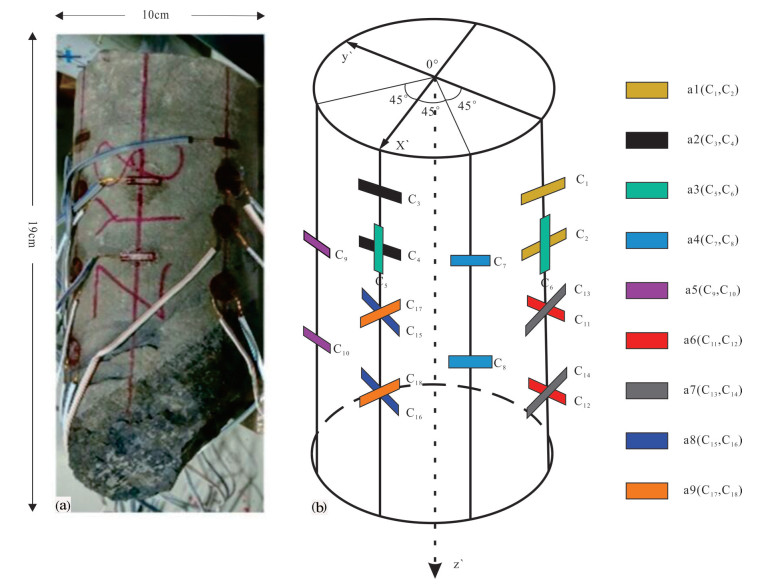
 下载:
下载:
